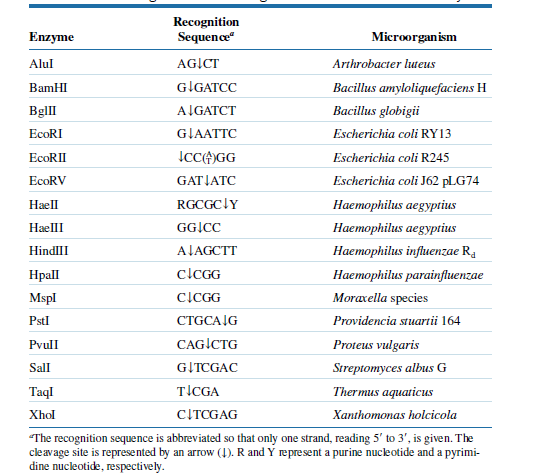Recognition Sequence" Enzyme Microorganism Alul AGICT Arthrobacter luteus BamHI GIGATCC Bacillus amyloliquefaciens H BgllI AIGATCT Bacillus globigii ECORI GIAATTC Escherichia coli RY13 ECORII ICCGG Escherichia coli R245 EcoRV GATJATC Escherichia coli J62 PLG74 Haell RGCGClY Наеторhilus aegyрtius HaellI GG|CC Haemophilus aegyptius HindlII ALAGCTT Haemophilus influenzae R4 Hpall clCGG Haemophilus parainfluenzae Mspl CICGG Moraxella species PstI CTGCAIG Providencia stuartii 164 Pvull CAGICTG Proteus vulgaris Sall GITCGAC Streptomyces albus G Тaql TICGA Thermus aquaticus Xhol CITCGAG Xanthomonas holcicola The recognition sequence is abbreviated so that only one strand, reading 5' to 3', is given. The cleavage site is represented by an arrow (1). R and Y represent a purine nucleotide and a pyrimi- dine nucleotide, respectively.
Molecular Techniques
Molecular techniques are methods employed in molecular biology, genetics, biochemistry, and biophysics to manipulate and analyze nucleic acids (deoxyribonucleic acid (DNA) and ribonucleic acid (RNA)), protein, and lipids. Techniques in molecular biology are employed to investigate the molecular basis for biological activity. These techniques are used to analyze cellular properties, structures, and chemical reactions, with a focus on how certain molecules regulate cellular reactions and growth.
DNA Fingerprinting and Gel Electrophoresis
The genetic makeup of living organisms is shown by a technique known as DNA fingerprinting. The difference is the satellite region of DNA is shown by this process. Alex Jeffreys has invented the process of DNA fingerprinting in 1985. Any biological samples such as blood, hair, saliva, semen can be used for DNA fingerprinting. DNA fingerprinting is also known as DNA profiling or molecular fingerprinting.
Molecular Markers
A known DNA sequence or gene sequence is present on a chromosome, and it is associated with a specific trait or character. It is mainly used as a genetic marker of the molecular marker. The first genetic map was done in a fruit fly, using genes as the first marker. In two categories, molecular markers are classified, classical marker and a DNA marker. A molecular marker is also known as a genetic marker.
DNA Sequencing
The most important feature of DNA (deoxyribonucleic acid) molecules are nucleotide sequences and the identification of genes and their activities. This the reason why scientists have been working to determine the sequences of pieces of DNA covered under the genomic field. The primary objective of the Human Genome Project was to determine the nucleotide sequence of the entire human nuclear genome. DNA sequencing selectively eliminates the introns leading to only exome sequencing that allows proteins coding.
Using the data in Table, identify restriction enzymes that (a) produce blunt ends; (b) recognize and cleave the same sequence (called isoschizomers); (c) produce identical sticky ends.

Trending now
This is a popular solution!
Step by step
Solved in 2 steps


